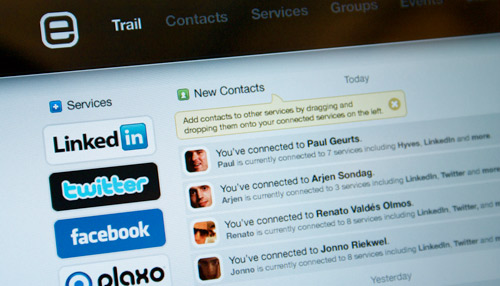Thoughts on Physical Social Networking
Go back to 1998 and remember when you had your shiny new Palm III PDA. It was the first of its kind to sport an infrared port. At the time, the killer feature of the Palm infrared port was not turning off walls of televisions at Best Buy but rather exchanging vCards with other Palm users - wireless business cards if you will. That never really took off though. A decade later and people are trying to give that concept another whirl, with a twist.
Hello My Name is E is the name of the site and they proclaim it is future of social networking.

The service revolves around users toting around a small device that when paired with another user's such device, exchanges contact information. This is where that whole wireless business card notion and reminiscence about the first Palm PDAs comes in.
E is a service and a device which give you the possibility to exchange contact information with a simple gesture. Hold two devices together for less than a second and they exchange contact information. Once you synchronize the device to a PC or Mac, the information you’ve collected is uploaded to the E service, where you can add your contacts directly to online services like LinkedIn or Facebook.
When the device is later synced with the service, it allows users to easily keep tabs on who they connected with and further manage their contacts on social networking sites; so it's not so much physical social networking as it is social networking facilitated by a physical device.

In a time when social networks are slowly embracing OpenSocial, E seems like a perfect in-the-meantime service. It definitely solves a problem I have dealt with when attending conferences and other events where there is a business card overflow issue.

The typical new contact workflow for most people might go something like emailing them and adding them on LinkedIn or Facebook. The problem is that with business cards that is an entirely manual process and usually involves Googling to find their Twitter account or personal blog. E gives you more than that, and in a digital format so you can add the contact to whatever services you wish, instantly.
The problem comes with adoption though. Sure this will be a boon for the very small percentage of Internet users that go offline and attend conferences, but how easy is it to make a few million E devices and ship them out to every user? Is it targeted at just tech-savvy conference-going networkers or is it also aimed at anyone that currently uses a business card? Hopefully these issues will solve themselves as E starts opening its doors to the public.
I wonder if something like E could be made with technology based around people taking cameraphone images of a special user identifier keychain or card and having the service use a sort of OCR to process the pictures. It would be cheaper than having to manufacture all those E devices, which the user might be charged for, although no public statement has been made about that.
If E was here and now, would you sign up and use it?